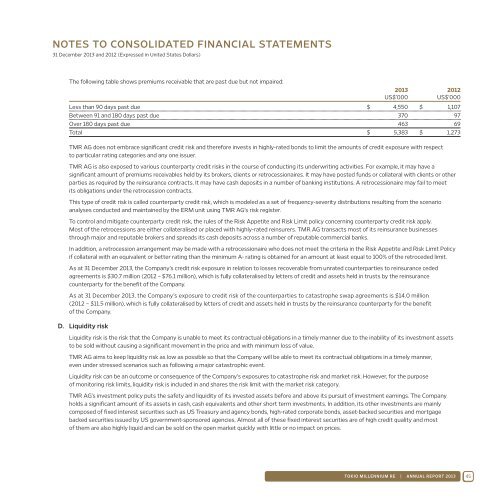ANNUAL REPORT 2013
Create successful ePaper yourself
Turn your PDF publications into a flip-book with our unique Google optimized e-Paper software.
NOTES TO CONSOLIDATED FINANCIAL STATEMENTS<br />
31 December <strong>2013</strong> and 2012 (Expressed in United States Dollars)<br />
The following table shows premiums receivable that are past due but not impaired:<br />
<strong>2013</strong> 2012<br />
US$’000 US$’000<br />
Less than 90 days past due $ 4,550 $ 1,107<br />
Between 91 and 180 days past due 370 97<br />
Over 180 days past due 463 69<br />
Total $ 5,383 $ 1,273<br />
TMR AG does not embrace significant credit risk and therefore invests in highly-rated bonds to limit the amounts of credit exposure with respect<br />
to particular rating categories and any one issuer.<br />
TMR AG is also exposed to various counterparty credit risks in the course of conducting its underwriting activities. For example, it may have a<br />
significant amount of premiums receivables held by its brokers, clients or retrocessionaires. It may have posted funds or collateral with clients or other<br />
parties as required by the reinsurance contracts. It may have cash deposits in a number of banking institutions. A retrocessionaire may fail to meet<br />
its obligations under the retrocession contracts.<br />
This type of credit risk is called counterparty credit risk, which is modeled as a set of frequency-severity distributions resulting from the scenario<br />
analyses conducted and maintained by the ERM unit using TMR AG’s risk register.<br />
To control and mitigate counterparty credit risk, the rules of the Risk Appetite and Risk Limit policy concerning counterparty credit risk apply.<br />
Most of the retrocessions are either collateralised or placed with highly-rated reinsurers. TMR AG transacts most of its reinsurance businesses<br />
through major and reputable brokers and spreads its cash deposits across a number of reputable commercial banks.<br />
In addition, a retrocession arrangement may be made with a retrocessionaire who does not meet the criteria in the Risk Appetite and Risk Limit Policy<br />
if collateral with an equivalent or better rating than the minimum A- rating is obtained for an amount at least equal to 100% of the retroceded limit.<br />
As at 31 December <strong>2013</strong>, the Company’s credit risk exposure in relation to losses recoverable from unrated counterparties to reinsurance ceded<br />
agreements is $30.7 million (2012 – $76.1 million), which is fully collateralised by letters of credit and assets held in trusts by the reinsurance<br />
counterparty for the benefit of the Company.<br />
As at 31 December <strong>2013</strong>, the Company’s exposure to credit risk of the counterparties to catastrophe swap agreements is $14.0 million<br />
(2012 – $11.5 million), which is fully collateralised by letters of credit and assets held in trusts by the reinsurance counterparty for the benefit<br />
of the Company.<br />
D. Liquidity risk<br />
Liquidity risk is the risk that the Company is unable to meet its contractual obligations in a timely manner due to the inability of its investment assets<br />
to be sold without causing a significant movement in the price and with minimum loss of value.<br />
TMR AG aims to keep liquidity risk as low as possible so that the Company will be able to meet its contractual obligations in a timely manner,<br />
even under stressed scenarios such as following a major catastrophic event.<br />
Liquidity risk can be an outcome or consequence of the Company’s exposures to catastrophe risk and market risk. However, for the purpose<br />
of monitoring risk limits, liquidity risk is included in and shares the risk limit with the market risk category.<br />
TMR AG’s investment policy puts the safety and liquidity of its invested assets before and above its pursuit of investment earnings. The Company<br />
holds a significant amount of its assets in cash, cash equivalents and other short term investments. In addition, its other investments are mainly<br />
composed of fixed interest securities such as US Treasury and agency bonds, high-rated corporate bonds, asset-backed securities and mortgage<br />
backed securities issued by US government-sponsored agencies. Almost all of these fixed interest securities are of high credit quality and most<br />
of them are also highly liquid and can be sold on the open market quickly with little or no impact on prices.<br />
TOKIO MILLENNIUM RE | <strong>ANNUAL</strong> <strong>REPORT</strong> <strong>2013</strong> 45


